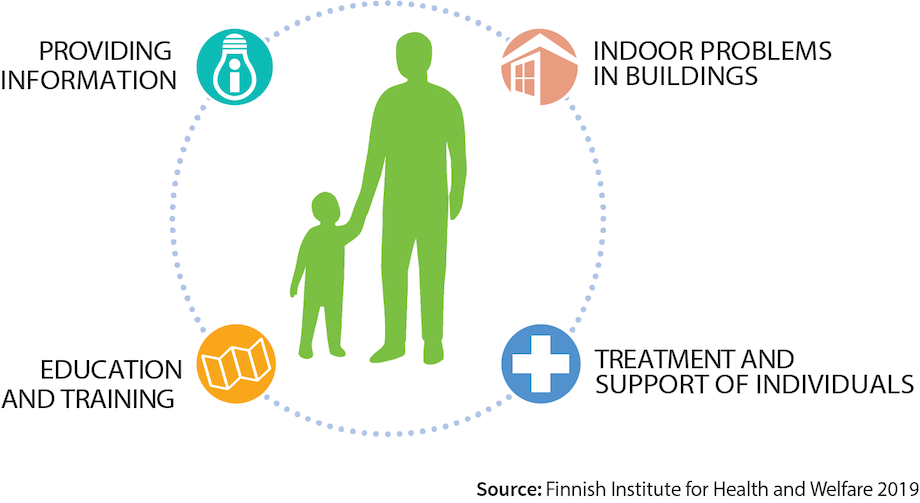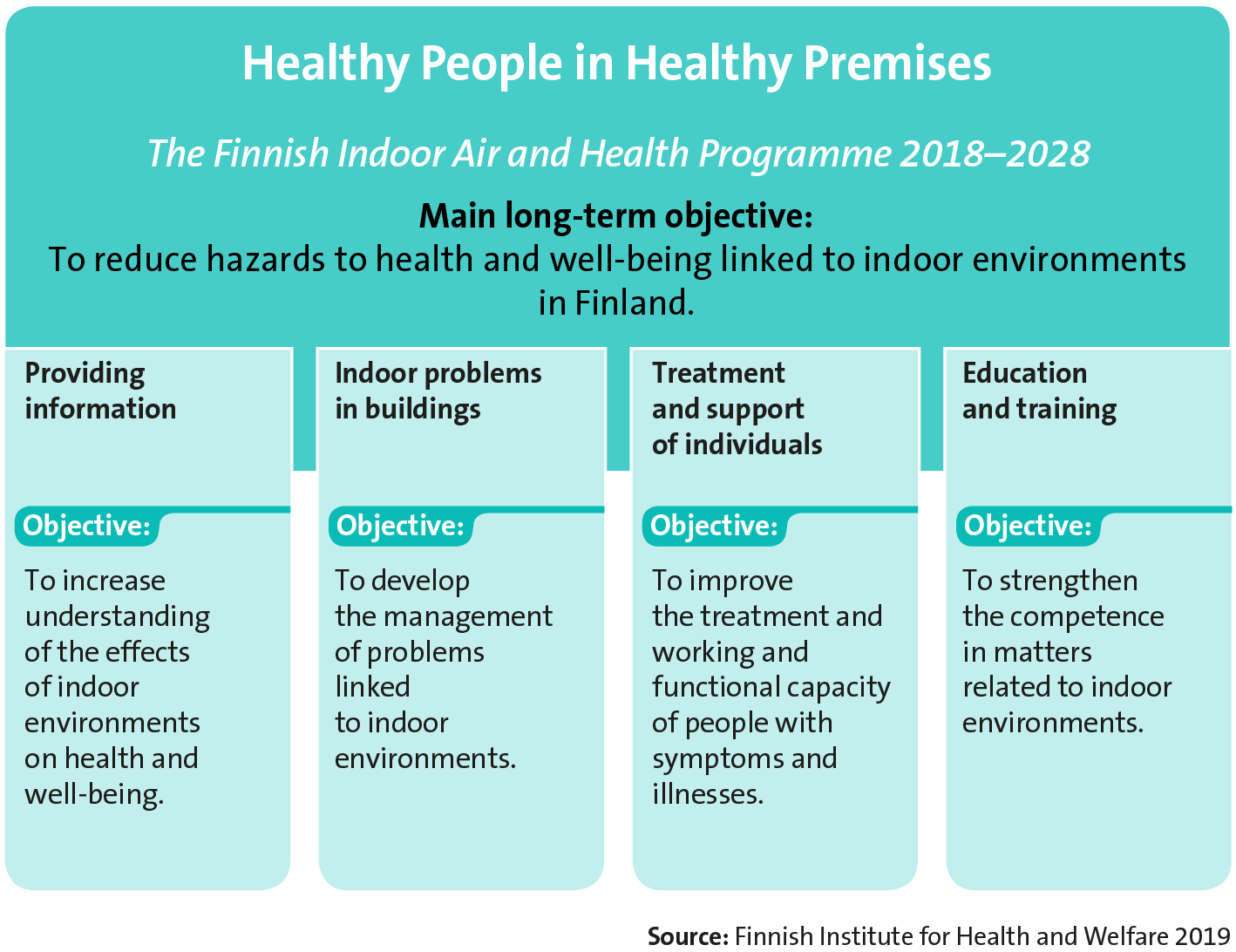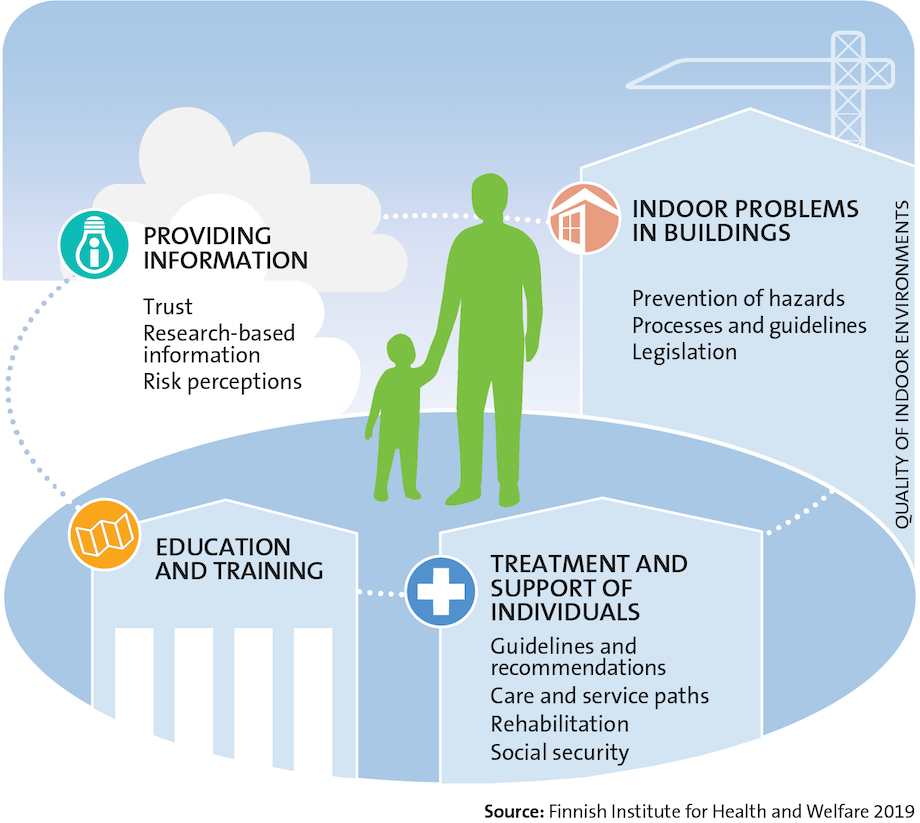The Finnish Indoor Air and Health Programme 2018–2028

Clean and fresh indoor air promotes health and well-being. However, in some cases indoor air can contain pollutants that may cause a variety of symptoms and reduce well-being. Individual exposure agents can also increase the risk of certain diseases. According to the Finnish parliamentary Audit Committee, the annual cost of health impacts caused solely by exposure to indoor pollution linked to water-related damages is in the range of 23–953 million euros. In addition to this, there are large costs related to the repair of buildings.
Finns have taken major steps to improve the quality of indoor air for several decades. From the international standpoint, we are forerunners in both research and providing guidance on indoor air quality. The primary focus of these activities has been the prevention and reduction of exposure to poor indoor air quality through guidance and regulation and directing remediation of damaged buildings. Water damage and visible mould are less common in Finland and also the levels of most other major indoor air pollutants are – on average – lower than levels found elsewhere in Europe, except for radon. Nevertheless, the reported symptoms related to poor indoor air quality are common in Finland.
Key problems with the current state
The problems related to indoor air are broad and complex and development is required in numerous areas. Improvements are needed in the management of indoor air pollutants and in the prevention, management and communication related to problem situations. Those who suffer from symptoms or illnesses in indoor environments are in need of help and support. The provision of diagnostic and treatment services, social security and other services that support rehabilitation still have shortcomings and must be improved. Further development of communication, education and training is also needed.
Because of the scale of the indoor air problems in Finland, considering the need for information and support among the general public and the large costs involved, new evidence-based methods, perspectives and solutions must be developed.

Finnish Institute for Health and Welfare (THL) initiated the preparation of the Finnish Indoor Air and Health Programme 2018–2028 in spring 2017, together with a number of collaborators and stakeholders, including the Finnish Institute of Occupational Health (FIOH). The primary, long-term objective of the Finnish Indoor Air and Health Programme is to reduce hazards to health and well-being linked to indoor environments in Finland. To fulfill this objective, the programme will focus on the promotion of human health and well-being, the prevention of hazards, improved communication and engage the health-care sector to manage better patients’ symptoms and complaints.
The ten-year Finnish Indoor Air and Health Programme consists of four areas that aim to:
- Increase understanding of the effects of indoor environments on health and well-being.
- Develop the management of problems linked to indoor environments.
- Improve the treatment and working and functional capacity of people with symptoms and illnesses.
- Strengthen the competence in matters related to indoor environments.
The progress of the programme and reaching the predefined, quantitative goals will be monitored throughout the programme.
Phasing of programme measures
According to the current plan, the measures of the Finnish Indoor Air and Health Programme will be implemented in two phases. Measures in phase I will be launched in 2018–2022. Phase I includes the launch of measures that were deemed to be the most important or most impactful during the design phase.
The intermediate evaluation of the progress of programme measures and achievement of its objectives is planned to be conducted in 2023. It will then be determined how many of the planned measures have been implemented, and it will be assessed and documented as to how well the objectives set for the programme being achieved.
Contact information
Anniina Salmela
Senior Researcher
Finnish Institute for Health and Welfare
tel. +358 29 524 7712
email: [email protected]
Anne Hyvärinen
Research Professor
Finnish Institute for Health and Welfare
tel. +358 29 524 6364
email: [email protected]
Juha Pekkanen
Professor
University of Helsinki/ Finnish Institute for Health and Welfare
tel. +358 29 524 6368
email: [email protected]




